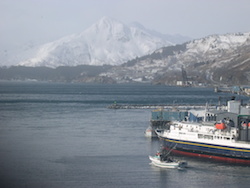On Thursday morning, it was 7 degrees below zero in Wells, Maine, and that’s pretty cold when you go out to start your car. But it’s even colder when it’s 1:30 a.m. and you’ve just been rousted out of your bunk to haul back.
Carvel Whaley, who I fished with on the Lady Jennifer in the winter of 1984 after my boat Hard Times had sunk, would let you wring every last second out of your mid-watch kink. Carvel was soft spoken and rather than bang on the stateroom door or holler at us to …grab our socks, he’d slow the engine down and throw the winches in gear. We’d awaken instantly and roll out on deck still digging the gunk out of our eyes. Depending on how deep we were fishing we might have 10 minutes before the doors came up, a few hundred seconds to jump into our oilskins, guide wire onto the drums, and pray the net was in one piece.
We were flounder fishing on pretty good bottom so we didn’t stave up often but when we did, Carvel was an excellent twine man and would work with us to get the net mended and back in the water.
Not all captains were so inclined, and some developed a reputation as “slipper skippers” in honor of the footwear in which they padded about the wheelhouse through the harshest winter weather and back-deck fiascos.
The Lady Jennifer was an 80-footer, or thereabouts, but had only one net reel, so fishing stopped when we rimracked. On boats with two reels you could set the second net if you destroyed the first one. This was efficient, but crews had mixed opinions about two reels because it meant there was no jumping back in the rack until the first net was fixed, however long it took.
I’m not a guy who thrives on cold weather — you’ll never see me shirtless at a Green Bay game with a big red letter painted on my stomach — but it didn’t bother me much in those days, especially once I yielded to common sense and started wearing long johns. My hands would get cold when I first came out on deck, but they’d warm up on their own and stay that way for hours, which is why I’d never leave the deck until we were done.
The warmest place for a deckhand was the fish hold (which also was the coolest place in the summer). I enjoyed working the hold and like most fishermen took considerable pride in the condition of my fish when they came out.
The Jennifer’s hold was nine or 10 feet deep, with another 18 inches or so to the top of the coaming, but there was no ladder. Instead, wooden blocks were fastened to a stanchion on either side of the slaughterhouse. You planted one foot, groped across perhaps five feet of hatchway for the next lower block on the other side, and worked your way up or down. It was fine once you got used to it, and it saved working around a ladder when shoveling ice, but it took getting used to.
In my case the learning curve may have steepened through weakness of the human flesh. My first trip as hold man commenced just a few hours after a Bat Juice marathon in which all hands, accompanied by their skipper, had joyously participated.
It was a late-winter night and despite the relative snugness of the hold I thought, once I’d managed to get down there without landing on my ass, that it was an open question whether or not they’d have to use the Gilson to hoist me out. But I made it on my own, as trawlermen have since they first cast their nets on the waters.







